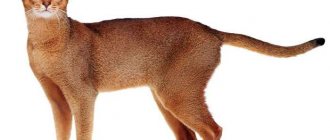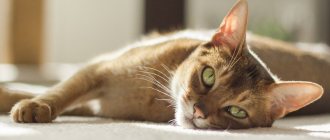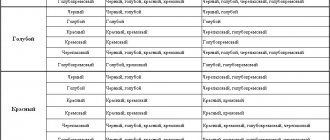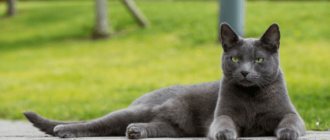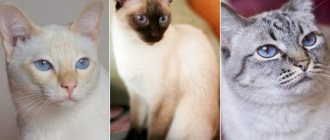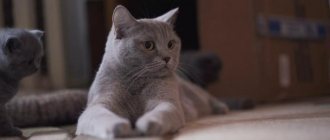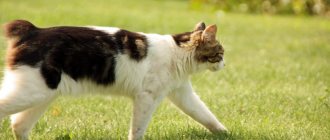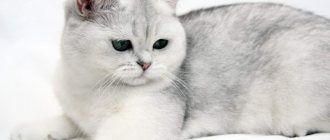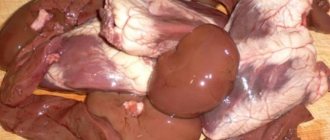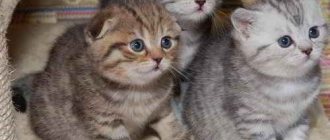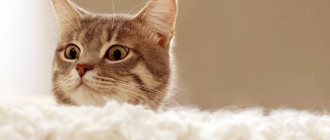General requirements for the breed
The breed that is genetically closest to Orientals is the Siamese. A layman can distinguish them only by the color of their eyes: Siamese have blue, and Orientals have green. The breed standards have the most stringent requirements for this characteristic: the green tint must be pure, bright, without a hint of contrasting spots.
This requirement is most difficult to apply to red, apricot and cream cats. But even among owners of other colors, the eye color is not always pure green - it can be greenish-yellow, or even orange, pure yellow. Thus, contrary to standards, only a small part of Orientals have the desired green eye color. The main thing for breeders here is consistent breeding: sometimes green-eyed parents produce offspring with an unclear shade of the iris, while yellow-eyed parents produce kittens with the ideal color.
Another important point of the standard is wool. In the Oriental, it is necessarily short and tightly adjacent to the body. Much attention is paid to tinting the hair - it is evenly colored to the very root. Moreover, the shade of the coat should match the skin tone.
One of the reasons for uneven color is fading. Orientals love to bask in the sun - the consequences of this habit are the appearance of unsightly rusty, yellowish spots on the fur coat.
Breed standards, regardless of coat color or color group, do not allow any white spots on the hair of an Oriental. This defect is often noticed on the throat (“medallion”) and on the tummy, in the “armpits”, “bikini” area, between the hind legs.
The formation of white marks is sometimes not associated with genetic factors. Snow-white hairs often appear at the site of wounds, on scar tissue. There is no need to worry if your kitten has long, “transparent” hairs on its coat. As a rule, this infant cover is completely gone by the 5-6th month of life - along with the first molt.
Abyssinian cat: 7 character traits
In addition to their exotic appearance, Abyssinians have unique habits. In many ways, their behavior is that of a wild animal, as if cats were not domesticated many thousands of years ago. Abyssinians have pronounced hunting instincts and are incredibly active cats. The breed has the following character traits:
Curious
The Abyssinian needs to stick his nose everywhere. Even when the apartment has been examined far and wide, the cat will find a new secluded place to sleep. Or it will try to catch a stream of water with its paw. Can watch the clothes spinning in the washing machine. In a word, nothing will be missed. New toys and objects invariably arouse interest and desire among Abyssinians to try them out.
The kitten happily sharpens its claws on a tree
Be mentally prepared for the fact that your pet will want to climb tables, cabinets and, in general, everywhere.
Playful, active
Even if you've read a hundred times how energetic Abyssinians are, you won't understand how energetic they are until you get your own. They have a jet engine hidden under their tail. Like a drop of mercury, the Abyssinian is always on the move and cannot sit in one place unless he is sleeping.
The Abyssinian breed among cats is like a husky among dogs. Ready to run and play around the clock. These cats are born acrobats. They jump high and deftly, and can do a somersault in the air or run along a wall.
And now I will bite you to death, human leg!
Sociable
Alone, Abyssinians get bored; they need communication and attention. When the owner is at home, they will always be nearby. These cats will greet you from work, raising their tails and meowing joyfully. Abyssinians often prefer to sleep with people in their arms, crawling under the covers.
Talkative
Abyssinian cats really make a lot of sounds. They can scream shrilly at 6 a.m. and throughout the day. They can sing songs while begging for food or simply out of boredom. But Abyssinians scream especially loudly and heartbreakingly during estrus.
The siren can also turn on if something is not pleasant - for example, if you lock your pet in a carrier while traveling by car.
Come on, let me out, I swear, you will regret it!
Affectionate
Abyssinian cats purr loudly and willingly. They themselves seek affection, butting a person with their heads and rubbing themselves on their legs. They lick and chew their hands, trample their knees with their paws, and willingly allow themselves to be stroked.
Trainable
Abyssinians love to play and are very intelligent - these qualities make them the most trainable cats in the world. They fetch, run after the toy again and again, learn to give a paw, sit and perform other tricks - it all depends on the imagination of the owners.
Get attached to people
A generally accepted stereotype: dogs love their owner, and cats love their home. But in the case of the Abyssinians this does not work. They feel sincere affection for their owner. The only problem is that the cat can choose one “favorite” person from the family.
Abyssinian cats do not tolerate separation well and get very bored when their owner is away
Black and blue
One of the most beautiful colors of Orientals is black. This is necessarily pure color from the roots to the ends of the hairs. A rusty tint and faded spots are not acceptable by breed standards.
This cat has a black nose and eyeliner. As for the paw pads, colors ranging from black to dark brown are allowed. The fur of such a cat is smooth, glossy, shiny, as if polished.
Photos of black oriental cats:
A “diluted” version of black, the effect of a weakened gene is blue color. The wool looks steely, metallic, with a silvery tint. The nose, eyeliner, and paw pads are gray. Kittens may be greyish-pink.
The color of blue oriental can be defined as dark gray. It must be uniform throughout the entire length of the hair. It is almost impossible to find light gray Orientals - the shorter the coat, the darker the color it will be.
In the photo - blue orientals:
Genetics of color
The unusual color of Abyssinian cats is a kind of calling card of the breed. It is caused by the presence in the genotype of animals of several genes, the combination or dominance of which determines coat color:
- The dominant agouti gene is “Ta”. It detects the presence of ticked hairs.
- Gene "Ttb". When dominant, it displays a “tiger” coloration.
- Gene "U". Smoothes out differences in coat color. When it is dominant, the pattern does not appear.
The color of a purebred Abyssinian cat depends on the combination of these genes planned by the breeders. Their influence has a prolonged effect. A kitten may be born with a pattern on its fur - spots or stripes, which will disappear over time.
Important! Experienced breeders claim that the presence of stripes in kittens is a defect of the breed. If the kitten has a gray, faded undercoat, this is evidence of a crossbreed.
The white spotting gene causes the appearance of spots on the belly and muzzle, white “socks” and the tip of the tail. These signs are not considered a defect, but they try not to use such animals for breeding.
Havana and lilac
Havana is a rich brown, chestnut color. Unlike “cinnamon,” “chocolate” is cold, not warm. The fur of some Havanas is so densely colored that they can easily be mistaken for black cats. The nose, eye rims, and paw pads of such animals are either brown or pinkish-brown. The color of each hair is evenly saturated.
Photos of chocolate orientals:
A diluted, weakened version of Havana is the lilac color. It is defined as a cool gray with a slight pinkish, lilac highlight. At the same time, the color should not turn into either dark gray or fawn. The nose, “rims” of the eyes, and the pads of the feet of such a cat are pinkish-lilac.
Lilac is one of the most difficult colors to breed. A considerable number of kittens are born too gray. Their fur lacks that wonderful pinkish highlight.
It should be noted that the most stringent requirements for the shade of the iris are in relation to the “Havana” and lilac color. The standards require a clear and vibrant green eye color.
Photos of lilac oriental cats:
One of the mysterious breeds: the origin of Abyssinian cats
There are beautiful legends according to which the origin of Abyssinian cats is traced back to wild steppe African cats. And the most favorite fan theory is that the beloved cats of the pharaohs of Ancient Egypt are the ancestors of modern Abyssinians. There really is an external resemblance to the animals depicted on the frescoes.
On the left is an Egyptian fresco, on the right is Abyssinia (Ethiopia) on a map of Africa
Fact: the genotype of Abyssinian cats indicates a lack of relationship with African cats of Tunisia and Egypt.
When people find out that the Abyssinians were bred and registered in Great Britain, they experience a real shock. We all know cheeky British cats, what does graceful and exotic Abyssinian cats have to do with it?
Abyssinia, also known as Ethiopia, is an ancient African state. The territory of the country became a transit point for Europeans on their way to India and China. The coastal lands were captured, including by the British. It was from there that Captain Barrett-Lenard brought an unusual cat to his homeland in 1874. His name was Zula, and he was registered in the stud book under the sonorous name “Abyssinian cat.” Unfortunately, there is no information about his descendants or other introduced animals.
Abyssinian cat
The Abyssinian breed was registered in England in 1896, and by 1905 there were already 12 sires listed in the stud books, their origins unknown. In 1907, a couple of Abyssinians went to America. These were silver-colored animals - Salt and Aluminum Second.
For a long time, the American and English branches of the breed developed in parallel, but after the Second World War there were practically no Abyssinians left in Europe. The breed was restored using American animals.
It was the American Abyssinians who had the refined, slender forms that are traditional among the breed today. And they got large, wide-set ears from oriental cats that previously participated in the breeding of Abyssinians.
Abyssinian cats did not immediately become what we know them today
Abyssinian cats were not always short-haired. The long-haired modification was recognized as a separate breed - Somalia. Crossbreeding between Abyssinian and Somali cats stopped only in the 1980s.
Cinnamon and the faun
The cinnamon color of the Oriental cat is a warm brown, dark sand. This is the color of cocoa, chocolate - warm, not cold like “Havana”. The nose of such a cat will be brown, pink-brown, and the shade of the paw pads will vary from pink to brown.
Photos of cinnamon (cinnamon) orientals:
Fawn is a fawn color with a warm pinkish highlight. If it turns gray, blue or cold pink, this is already a non-compliance with the standard. Faun is softer, gentler than lilac. The color also looks a little lighter. Such a cat's nose, eyeliner and paw pads will be pinkish-fawn.
Photos of oriental cats of the “fawn” color:
Is it difficult to keep an Abyssinian cat?
An Abyssinian cat will have virtually no hair in the apartment - they do not have a pronounced undercoat. For the same reason, Abyssinians are real freezing creatures who seek warmth near the radiator, under the blanket, in their arms. If the apartment is cold, you even have to buy special clothes for the cat.
But the main features of keeping Abyssinian cats are associated with their stormy temperament. They are not prone to obesity, and with proper feeding they maintain a slim figure even after sterilization. But the risk of injury is extremely high.
You're fat yourself, give me more food, man!
The owner’s task is to hide all small things, wires and other dangers from the curious Abyssinian. Having played with the hunt, cats swallow a variety of foreign bodies - rubber bands, balls, threads, headphones.
Strong mosquito nets must be installed on the windows; ordinary mosquito nets will not save the cat from falling. At the same time, it is unacceptable to open double-glazed windows for vertical ventilation, otherwise the pet may get stuck.
All cats love boxes
Abyssinian cats are prone to sudden movements. Frightened as a joke or seriously, in a game, they take off right off the bat, leading their impressionable owners to a heart attack. They can jump vertically from a place. Fractures in kittens of this breed are not uncommon.
You should not leave your Abyssinian in the kitchen where the stove is on, and you should not leave breakable things like glass vases on the tables.
Abyssinian Sorrel cat
These cats need to be given a lot of attention - not only affection, but also active games. They can hunt for a toy mouse or a red dot of a laser until they become short of breath, and after sitting for a few minutes with their tongue hanging out, they begin to run after it again. Like a drop of mercury, Abi is always on the move. When you don’t sleep, you simply cannot sit in one place for a long time.
If you still don’t understand what kind of energizer this is, imagine that the kitten will have fun like this:
- Hang on curtains;
- Hunt for the rag you use to clean the floor;
- Catching your toothbrush while you brush your teeth;
- To rush to your feet from an ambush;
- Stealing cotton swabs;
- Chew wires;
- Jumping in a duvet cover or under a sheet;
- Devour flowers and dig the ground.
And this is just a small list of all kinds of mischief. An Abyssinian kitten will require a lot of your time and patience. In any case, it won't be boring.
If you have the opportunity to walk outside, the amount of damage to your home decreases
Red, apricot and cream
An unusual group of colors, which is characterized by a pattern on the coat - tabby. All three of these colors have varying degrees of pronounced red color. The depth of color is individual for each cat.
Red is the richest and brightest red. Apricot is a more diluted, delicate version. This is a warm color, but with the obligatory metallic tint. Cream - less intense, even lighter. Steely shine is not welcome here - this is a softer, somewhat smoky color.
Photos of red, cream, apricot orientals:
Reviews from Abyssinian cat owners
“Raj is a wild color, a real handsome man. He turned out to be capricious, he would hit back with his clawed paw without hesitation. I can’t stop him from climbing on tables, and there was a mistake about the scratching post - the whole apartment is a scratching post for him. At the dacha he catches birds and mice, and is also accustomed to walks on a harness. The breed is not for everyone, that’s for sure, although the beauty is certainly indescribable.”
“I still regret that I sterilized Vesta when she was six months old. What kittens would be from my aristocratic sorrel colored female! No matter what I do, she is always there, supervising and participating in the process. My first cat who looks not with contempt, but with love! He can lick my face, comes to rattle in bed. Abyssinians are amazing, the best breed in the world"
“For me, an Abyssinian cat is the feline ideal of beauty, a goddess, a supermodel. In addition, they are graceful and smart. You can buy one like this for any money - and purebred kittens are not cheap! Our Tasya is already 3 years old, I am jealous of her husband - she chose him as her favorite owner, and the fact that I feed and clean the tray is not good for her. I still run and photograph her every day – I’m delighted!”
“Terry came to us almost by accident - I was looking for a Siamese cat, it’s a long story, but in the end, Abi settled with us. What a demon, I tell you! We built him a climbing frame for the whole apartment and worship him like two-legged slaves. All pranks are forgiven, but the khan is being repaired.”
Interesting facts about the breed
- The main fame of Abyssinian cats is associated with their energy and activity, which often leads to hooligan actions. You can often hear from owners that there are too many of them in their lives.
- The Abyssinian is usually a very good mother. It can lamb without outside help and hatch its offspring independently.
- Pets of this breed are very similar in character to dogs. They are devoted to their owner, which is not typical for a cat family that tends to become attached to the house.
Pros and cons of the breed
Any animal has its positive and negative factors. The advantages of this breed include:
- Lack of wool in the house. The breed has short hair; if you brush it once a week, it will not leave marks behind.
- The mustachioed friend does not yell and speaks quietly, which does not interfere with the owners’ rest.
- The breed is playful and never tires of its owners playing with it and paying enough attention to it.
- Such cats are neat and gentle. When playing with children, they do not release their claws so as not to touch the baby with their paw.
- They are satisfied with toys made from scrap materials.
The Abyssinian breed has much fewer disadvantages:
- The pet constantly runs, which can irritate a person.
- The cat loves to sit on high places. You must be prepared that the animal will spend most of its time on cabinets, mezzanines, etc.
- You need to provide the animal with affection, care, tenderness, as they need it. If you are sure that you will not be able to devote enough time to a cat, then it is better not to buy one.
Abyssinian red cat
How to choose a kitten
You need to purchase Abyssinians from reputable breeders or large nurseries with a good reputation. First, it is recommended to get acquainted with the photos of Abyssinians offered for sale.
The kitten must be prepared for sale:
- he must be at least three months old;
- the required vaccinations have been completed;
- the baby must be trained to the tray;
- Weaned from maternal nutrition and transferred to an independent diet.
Important! When purchasing Abyssinian kittens, you need to be aware of the breed's susceptibility to genetic diseases. It is imperative to check with the breeder whether there are genetic tests to detect pathologies in the parents.
The main signs that Abyssinian kittens are healthy:
- They have a playful character, make contact easily, and do not look timid.
- The shiny iridescent fur has no scuffs.
- The gait is confident, the movements are active.
- When palpating the abdomen, there are no hernias or bloating.
- There is no purulent discharge from the eyes or ears.
Important! The breeder must provide a complete package of documents. The pet passport must contain vaccination information. The pedigree must indicate that there were no inbreedings in the breed. Certificates of genetic testing.
Abyssinian kittens photos
2 kittens
3 kittens
with a toy
with a ball
plays
resting
What is this?
yum
tired
I want to sleep
What?
…
1 Week
Cost of the Abyssinian breed
In Russia, the popularity of the Abyssinian cat breed is only increasing and the cost of an Abyssinian cat depends on the class:
- Pet - a simple home companion with the condition of mandatory castration - approximately 15-30 thousand rubles .
- Breeding - healthy kittens with positive tests for the absence of genetic pathologies for further reproduction with the opportunity to be exhibited will cost from 30,000 to 45,000 rubles.
- Show - kittens with a prestigious pedigree and with the right to breed and participate in exhibitions, the price of which can reach from 65,000 to 85,000 rubles.
Important! How much Abyssinian cats cost largely depends on where they were purchased. Selling cheaper animals through advertisements may have the risk of acquiring a genetically diseased pet.
Nurseries
If a potential owner needs an Abyssinian kitten for home, then you can buy it cheaper, but better from breeders or nurseries.
Catteries with positive reviews where Abyssinian kittens are bred:
- Republic of Belarus, Minsk. Nursery, ABYMASCOT, version of the CFA / WCF standard. Contacts: +375292804312.
- Russia, Krasnodar. Nursery BLACK HAZEL, version of the CFA / WCF standard. Contacts.
- Russia Moscow. Nursery Gold Pandora Aby Cattery, CFA / WCF standard version. Contacts: +79999677778.
- Russia, Saint-Petersburg. SILK TASSEL nursery, version of the CFA / WCF standard. Contacts: +79214118010 “Shining By”,
